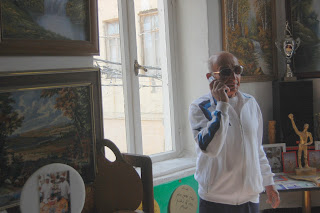Tel Aviv's transformation
 No 14, designed for the rich.
No 14, designed for the rich.There has been a flurry of articles on Tel Aviv in the national media over the past few weeks.
Ha'aretz (following a PR blitz at the paper's offices by controversial mayor Ron Huldai and his image makers) wrote what one critic called a "panegyric" (look it up) on the dramatic development of the city over the past decade. Ma'ariv featured the downside of Huldai's accomplishments.
As Uri Misgav wrote in a critique of the Ha'aretz piece:
"No-one one disputes the fact that Huldai has advanced Tel Aviv in certain areas. But his tenure, particularly his second term, is far from a matter of consensus. Alongside construction enterprises, his "bulldozer" also sows destruction and anguish."
To sum up the arguments. On the plus side ,Huldai has fixed crumbling infrastructure ignored for decades, beautified the city's boulevards and developed formerly run down areas like Tel Aviv port and has turned them into bustling entertainment centres. In the process Tel Aviv has reversed its negative demographics and today is the most desirable city in the country.
On the downside, he has :encouraged the construction of unsightly towers designed for the rich and cut off from their surroundings ; acted to destroy some of the city's most beloved landmarks (like Hapoel Tel Aviv's basketball hall on Usishkin St. or the Gordon Pool) and wants to root out the neighbourhood pubs and cafes that give substance to Tel Aviv's claim to be the "city that never stops." In the process, soaring apartment prices are now shutting out the students, artists and young couples who turned the city into a lively, colourful metropolis from the early 1990s onwards.
As Misgav wrote: "These moves... affirm that Huldai does not understand in depth the secret of the metropolis' power and beauty. The mayor, who confessed during his first term that he "did not fall in love" with Tel Aviv, insists on observing it through real estate and utilitarian lenses. His declared inclination to root out the pubs and restaurants from the city's streets in favor of distant ghettos of "entertainment zones" attests to estrangement and a lack of understanding. The city's residents steer clear of those places, and their love for Tel Aviv is based on just the opposite - the neighborhood coffee shop, pub and grocery store, like in Manhattan or Paris."
Meanwhile, the construction of high-rises that is transforming the city's once modest skyline into Manhattenesque proportions continues apace. The immediate area around the rooftop, thankfully full of old buildings on the conservation list, is out of bounds for skyscrapers but in a few years it too will have been transformed. On our street alone work continues on nos 9 & 14 and will soon start on nos 2, 6 and 10 ! All these apartment blocks will cater for the rich with apartment prices reaching millions of dollars. One of the results has been to bounce up the value of the apartments in our own modest building. Nice for us but less so for a young couple on a modest income looking to move into the neighbourhood.How ironic that the real estate boom is fueled by the wave of nostalgia for 'Bauhaus' architecture whose ideology was to provide affordable utilitarian housing for the masses.
Tel Aviv's history and scale is swept aside wherever a new tower appears. In the picture below the burnt-out building in the foreground was once a villa surrounded by citrus orchards. In the background, the menacing Neve Tsedek Tower blots out the sky.




Comments